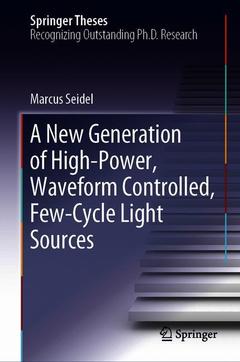Description
A New Generation of High-Power, Waveform Controlled, Few-Cycle Light Sources, 1st ed. 2019
Springer Theses Series
Author: Seidel Marcus
Language: English
Subject for A New Generation of High-Power, Waveform Controlled...:
Approximative price 105.49 €
In Print (Delivery period: 15 days).
Add to cart227 p. · 15.5x23.5 cm · Hardback
Description
/li>Contents
/li>Biography
/li>Comment
/li>
This thesis presents first successful experiments to carrier-envelope-phase stabilize a high-power mode-locked thin-disk oscillator and to compress the pulses emitted from this laser to durations of only a few-optical cycles. Moreover, the monograph introduces several methods to achieve power-scalability of compression and stabilization techniques. All experimental approaches are compared in detail and may serve as a guideline for developing high-power waveform controlled, few-cycle light sources which offer tremendous potential to exploit extreme nonlinear optical effects at unprecedentedly high repetition rates and to establish table-top infrared light sources with a unique combination of brilliance and bandwidth. As an example, the realization of a multi-Watt, multi-octave spanning, mid-infrared femtosecond source is described. The thesis starts with a basic introduction to the field of ultrafast laser oscillators. It subsequently presents additional details of previously published research results and establishes a connection between them. It therefore addresses both newcomers to, and experts in the field of high-power ultrafast laser development.
Introduction.- Proof of Concept: Few-Cycle Pulse Generation and Carrier-Envelope-Phase Stabilization.- Power Scalable Concepts.- From the Near- to the Mid-Infrared.- Outlook and Conclusions.- Appendix.
Nominated as an outstanding Ph.D. thesis by the Max Planck Institute of Quantum Optics, Garching, Germany
Readily understable introduction to the field
Fully illustrated with extensive reference list




